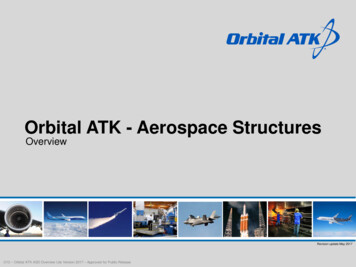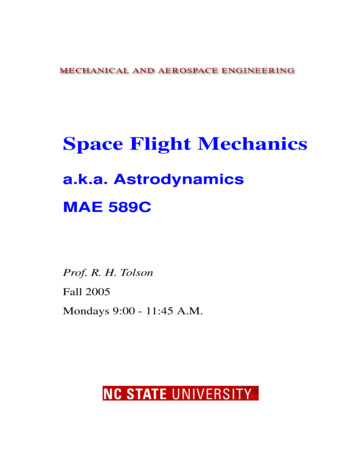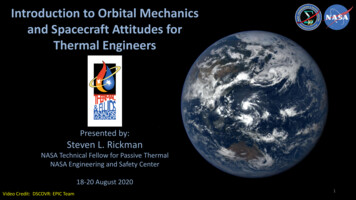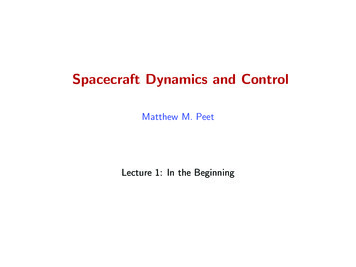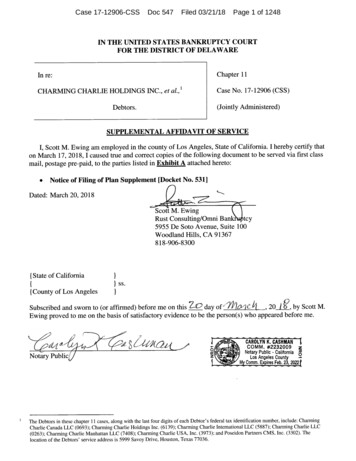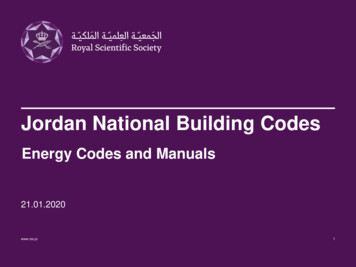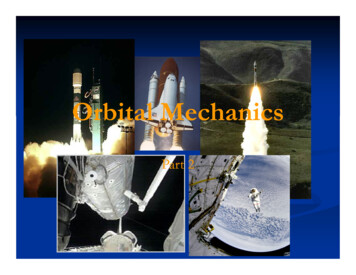
Transcription
Orbital MechanicsPart 2
Orbital ForcesWhy a Sat. remains inorbit ?Bcs the centrifugal forcecaused by the SatSat. rotationaround earth is countercounter-balanced by the Earth's PullPull.A body in circular motion will have aconstant velocity vcirc determined by theforce it must “balance” to stay in orbitvcircGM r
Escape velocity Escape velocity is the velocity a mass must have toescape the gravitational pull of the mass to which itis “attracted”. We define a mass as being able to escape if it canmove to an infinite distance just when its velocityreaches zero. At this point its net energy is zeroand so we have:GMm 12 mv escr2vesc 2GMr
Escape velocity
Orbital EnergyGMm m 2 GMmE v 2a2r Inthe solar system, bodies observed: planets etc. elliptical, some nearly circular;comets elliptical, parabolic, hyperbolic;some like comets or miscellaneous debrishave low energy orbits and we see themplunging into the Sun or other bodiesorbit typevEtotcircularv vcircE 0ellipticalvcirc v ves E 0ee 00 e 1cparabolicv vescE 0e 1hyperbolic v vescE 0e 1
Injection Requirements: Speed5m8 km
Injection Requirements: Speed17,500 mi/hr100 miles
Injection Requirements: AltitudeAre you moving FASTER or SLOWER thehigher your altitude?
Injection Requirements: Altitude3EVC 4.56 km/s2EVC G(m1 m2)aVC 5.59 km/s
Injection Requirements: AltitudeV E VC 2 7.91 km/sV 7.91 km/sV 7.91 km/sVC 5.59 km/s2E
Injection Requirements: Direction
Vis--Viva EquationVis Knowing the relation between orbital energy,distance, and velocity we can find a generalformula the Vis Viva equationGMm m 2 GMm v 2a2r 1 1 v ( r ) 2GM r 2a 2 Does not depend on orbital eccentricity. If a new object is observed in space, knowing itscurrent velocity and distance, we can determine itsorbital semimajor axis, and, thus have some ideawhere it came from.
Vis--viva equationVis A meteor is observed to be traveling at a velocity of 42 km/sas it hits the Earth’s atmosphere. Where did it come from?
Resonances If the orbit of a smallbody around a larger oneis a smallsmall-integer fractionof the larger body’speriod, the two bodies arecommensurable.Some resonances (3(3:2resonance of Jupiter)actually have a stabilisingeffect.Example: An asteroid in a 1:2 resonance with Jupitercompletes two revolutions, while Jupiter completes one
Horseshoe orbits Two small moons of Saturn, Janus andEpimetheus, only separated by about50 km.As inner (faster moving) moon catchesup with slower moon, it is given agravitational kick into a higher orbit.It then moves more slowly and lagsbehind the other moon.
Coordinate Systems Defines positions and directions in a consistentmanner -- allows communicationFacilitates the description of a satellite’s positionand subsequent motionProper choice of reference determines the utilityof a coordinate system
Coordinate SystemsClassifications Inertial NonNon--rotating Time IndependentNon--inertialNon Rotating TimeDependent
Coordinate SystemsExamplesGeographic Geocentric Inertial Topocentric Orbit Inertial
Coordinate SystemsGeographic Purpose: To locate points on the Earth’ssurface
Coordinate SystemsGeographic Purpose: To locate points on the Earth’ssurface
Coordinate SystemsGeocentric Inertial Purpose: To determine the exact orientation of anorbital plane and to locate points in space with respectto the EarthEcliptic PlaneVernal EquinoxEquatorialPlane
Coordinate SystemsGeocentric InertialInclination
Coordinate SystemsGeocentric InertialDirection ofSatellite motionVernalEquinoxAscending NodeRight Ascension
The Orbital Plane In the orbital plane, theposition vector r andvelocity vector v specifythe motion ofthesatellite.a (1 e 2 )r 1 2 cos vKnowing the mean anaomaly, the eccentric anamaly E :M E e sin E Knowing E:M E e sin E 0 (Iterative Sol.)v1 eEtan( ) tan( )21 e2For near Circular Orbits (e (e 0):r a (1 2 cos E )5 2v M 2e sin M e sin 2 M4
Example
Example
Examplea (1 e 2 )r 1 2 cos v
The Perifocal (PQW) System The position vector in thePerifocal coordinate system(PQW):r (r cos v)P (r sin v)Q
The GeocentricGeocentric-equatorial (IJK) Frame PQW is conveniet for motiondescrptionEquatorial Bulge causesrotationsof PQW systemGeocentric is suitable:refernced to fixed starsThe transformation invector notation btewwnPQW and IJK frames:
Example
Coordinate SystemsOrbit Inertial Purpose: To fix the satellite orbit in the orbitalplanePerigeeArgument ofPerigeeAscending Node
Coordinate SystemsTopocentric Purpose: To locate a satellite with respect to aspecific point on the Earth
Coordinate SystemsTopocentricElevation
Coordinate SystemsTopocentricAzimuthRangeOrigin: AntennaFP: Local HorizonPD: True North
The TopocentricTopocentric-horizon System The position of the sat.measured from the erathstattion in terms of theazimuth, elevation andrangeThe fundamental plane isthe observer x x south (S) y east (E) z up up zenith (Z)(SEZ frame)
The TopocentricTopocentric-horizon System The position of the sat.measured from the erathstattion in terms of theazimuth, elevation andrange
Example Given
Coordinate SystemsOrbit Inertial Purpose: To fix the satellite orbit in the orbitalplanePerigeeArgument ofPerigeeAscending Node
Orbit ClassificationSize/Period Location Shape
Orbit ClassificationSize/Period Defined by semisemi-major axis (a)Low Earth Orbit (LEO)High Earth Orbit (HEO)Semi--synchronous OrbitSemiGeo--synchronous OrbitGeo
Orbit ClassificationLocation EquatorialPolar
Orbit ClassificationShape (Conic Sections)CircleEllipse
Orbit ClassificationShape (Conic Sections)Trajectories:ParabolaHyperbola
ORBIT CLASSIFICATIONSCircular Orbits CharacteristicsConstant speed Nearly constant altitude Typical MissionsReconnaissance/Weather (DMSP) Manned Navigational (GPS) GeoGeo--synchronous (Comm sats)
ORBIT CLASSIFICATIONSElliptical Orbits CharacteristicsVarying speed Varying altitude Asymmetric Ground Track Typical MissionsDeep space surveillance (Pioneer) Communications (Polar comm.) Ballistic Missiles
ORBIT CLASSIFICATIONSParabolic/Hyperbolic Trajectories CharacteristicsEscaped Earth’s gravitational influence Heliocentric Typical Missions Interplanetary exploration (Galileo,Phobos, Magellan)
ORBIT CLASSIFICATIONSOrbit GeometryEccentricity c/aaPerigeeApogeecc
ORBIT CLASSIFICATIONSEccentricitye 0e 10 e 1e 1
ORBIT CLASSIFICATIONSEccentricityEccentricity c/ac 0caae 00 e 1
ORBIT CLASSIFICATIONSEccentricitye 0.75e .45e 0Eccentricity c/a
ORBITAL MECHANICS OriginsPhysical LawsRequirements for InjectionClassifications of OrbitsCoordinate Reference SystemsOrbital Elements
Satellites Several typesLEOs - Low earth orbitMEOs - Medium earth orbitGEOs - Geostationary earth orbit
GEOs Originally proposed by Arthur C. ClarkeCircular orbits above the equatorAngular separation about 2 degrees - allows 180satellitesOrbital height above the earth about 23000miles/35000miles/35000kmkmRound trip time to satellite about 0.24 seconds
GEOs (2( 2) GEO satellites require more power forcommunicationsThe signal to noise ratio for GEOs is worsebecause of the distances involvedA few GEOs can cover most of the surface ofthe earthNote that polar regions cannot be “seen” byGEOs
GEOs (3( 3) Since they appear stationary, GEOs do notrequire trackingGEOs are good for broadcasting to wide areas
TELSTAR Picture from NASA
SYNCOM 2 Picture from NASA
원격지구물리 2004년 1학기 3월 11일 목요일 1교시Satellite Orbits인공위성 궤도
Launch AnimationNASA serverKNU Server:no sound but storable
Low Earth Orbits저궤도 Close to Earth (320(320 800800km)km) 2727,,000 km/h90min90min periodSpace ShuttleSome Remote SensingSatellites and weathersatellites 8,000 Space Junks –satellites, old rockets, metals,etc.
Polar Orbit극궤도 One type of LEOHigh inclinationCan scan the entiresurface due to earthrotation (east(east-west)and satellite orbit(north--south)(northMost remote sensingsatellites and someweather satellites
Sun--synchronous OrbitSun These orbits allows a satellite to pass over asection of the Earth at the same time of day.Since there are 365 days in a year and 360 degreesin a circle, it means that the satellite has to shift itsorbit by approximately one degree per day.These satellites orbit at an altitude between 700 to800 km.These satellites use the fact since the Earth is notperfectly round (the Earth bulges in the center, thebulge near the equator will cause additionalgravitational forces to act on the satellite.This causes the satellite's orbit to either proceed orrecede.These orbits are used for satellites that need aconstant amount of sunlight.Satellites that take pictures of the Earth wouldwork best with bright sunlight, while satellites thatmeasure longwave radiation would work best incomplete darkness.
Reminder : WATER MISSION on a Sun-Sync. orbiFrequencyKa (36.5 GHz)Altitude824.03 kmBandwidth200 MHzInclination98.705 ºPulse duration6,3 μsCycle duration16 daysPRF (2 antennas)9000 HzPeak emission power1500 WMean instrument power800 WAntenna length3.80 mAntenna width0.28 mMast length10 mNear range view angle0.6 degFar range view angle4.3 degSpeed vectorSun directionin a 32deg half conePerpendicular to the orbit3.6 0.6 Resolution:10 m (FR) 70 m (NR)2mAltiKanadirswathInterferometric swathPolarisation VInterferometric swathPolarisation H50 km10 km10 km50 kmFig. 4: Conceptual illustration of the WatER mission
Geosynchronous Orbit지구정지궤도 Satellite is always at the sameposition w.r.t the rotating earthAltitude: 3579035790kmkm exactlyT 23T 23hrshrs 5656minmin 4.0909secsec‘Big--picture view’‘BigBroadcast or CommunicationsatellitesOrbit plane Earth rotationplane
Elliptical OrbitApogee타원궤도 Perigee(closest),Apogee(farthest)Period: 12 12hrshrsPolar coverageCcommunicationsatellites for north andsouth regionPerigee
Orbit Size and ShapeParameter Definition Semimajor Axis: Half the distance betweenthe two points in the orbit that are farthestapartApogee/Perigee Radius: Measured fromthe center of the Earth to the points ofmaximum and minimum radius in the orbitApogee/Perigee Altitude: Measured fromthe "surface" of the Earth (a theoretical spherewith a radius equal to the equatorial radius ofthe Earth) to the points of maximum andminimum radius in the orbitPeriod: The duration of one orbit, based onassumed twotwo-body motionMean Motion: The number of orbits persolar day (86(86,,400 sec/sec/2424 hour), based onassumed twotwo-body motionEccentricity: The shape of the ellipsecomprising the orbit, ranging between aperfect circle (eccentricity 0) and a parabola(eccentricity 1)
Orbit Period Universal Law ofGravitation CentripetalForceGMm2 mr r22 T2 4 T GM2 3 r T is proportional to r T only depending on the mass ofthe central body It holds for elliptical orbit when r isa, the semi-major axis of the ellipse. T 2 / a 3 is constant for everysatellites
Orbit OrientationParameter Definition Inclination: The angle between theorbital plane and the Earth's equatorialplane (commonly used as a referenceplane for Earth satellites)Right Ascension of the AscendingNode: The angle in the Earth'sequatorial plane measured eastwardfrom the vernal equinox to theascending node of the orbitArgument of Perigee: The angle, inthe plane of the satellite's orbit,between the ascending node and theperigee of the orbit, measured in thedirection of the satellite's motionLongitude of the Ascending Node:The EarthEarth-fixed longitude of theascending node
Satellite LocationParameter Definition True Anomaly: The angle from theeccentricity vector (points toward perigee) tothe satellite position vector, measured in thedirection of satellite motion and in the orbitplane. Mean Anomaly: The angle from theeccentricity vector to a position vector wherethe satellite would be if it were always movingat its angular rate. Eccentric Anomaly: An angle measured withan origin at the center of an ellipse from thedirection of perigee to a point on acircumscribing circle from which a lineperpendicular to the semimajor axis intersectsthe position of the satellite on the ellipse. Argument of Latitude: The sum of the TrueAnomaly and the Argument of Perigee. Time Past Ascending Node: The elapsedtime since the last ascending node crossing. Time Past Perigee: The elapsed time sincelast perigee passage.
INCLINATIONFUNCTION OF LAUNCH AZIMUTH AND LAUNCH SITE LATITUDEcos i (inclination) cos (latitude) sin (azimuth)NNorth 0 degrees Azimuthazimuth270o90oEastWest180ocos i cos (lat) sin (az)sin 90o 1sin 0o 0sin 180o 0sin 270o -1SouthSlaunch azimuth from 180o to360o retrograde orbitlaunch azimuth from 0o to 180o posigrade orbit
Celestial SphereArgument ofPerigee (w)PerigeeCelestialEquatorInclinationRight AscensionOrbit TraceW
ORBITAL MECHANICS: GROUND TRACESINCLINED ORBITSATORBIT 4ORBIT 3ORBIT 2ORBIT 1EQUATORIAL ORBITMULTIPLE ORBITSEARTH MOTION BENEATH SATELLITEANGLE OF INCLINATION(0 DEG. FOR EQUATORIAL)GROUND TRACESTHE POINTS ON THE EARTH’S SURFACE OVER WHICH A SATELLITE PASSES AS ITTRAVELS ALONG ITS ORBITPRINCIPLE : GROUND TRACE IS THE RESULT OF THE ORBITAL PLANE BEING FIXED ANDTHE EARTH ROTATING UNDERNEATH ITAMPLITUDE OF GROUND TRACE (LATITUDE RANGE) IS EQUAL TO THE ORBITAL INCLINATIONMOVEMENT OF GROUND TRACE IS DICTATED BY THE SATELLITE ALTITUDE AND THE CORRESPONDINGTIME FOR IT TO COMPLETE ONE ORBIT
ORBITAL MECHANICS: SPECIFICORBITS AND APPLICATIONS POLAR (100- 700 NM AT 80 - 100 DEG. INCLINATION)– SATELLITE PASSES THROUGH THE EARTH'S SHADOW AND PERMITS VIEWING OF THEENTIRE EARTH’S SURFACE EACH DAY WITH A SINGLE SATELLITE SUN SYNCHRONOUS (80 - 800 NM AT 95 - 105 DEG INCLINATION)– PROCESSION OF ORBITAL PLANE SYNCHRONIZED WITH THE EARTH’S ROTATION SOSATELLITE IS ALWAYS IN VIEW OF THE SUN– PERMITS OBSERVATION OF POINTS ON THE EARTH AT THE SAME TIME EACH DAY SEMISYNCHRONOUS (10,898 NM AT 55 DEG INCLINATION)– 12 HR PERIODS PERMITTING IDENTICAL GROUNDTRACES EACH DAY HIGHLY INCLINED ELLIPTICAL (FIXED PERIGEE POSITION)– SATELLITE SPENDS A GREAT DEAL OF TIME NEAR THE APOGEE COVERING ONEHEMISPHERE– CLASSICALLY CALLED “MOLNIYA ORBIT” BECAUSE OF ITS HEAVY USE BY THERUSSIANS FOR NORTHERN HEMISPHERE COVERAGE GEOSYNCHRONOUS (GEO) (CIRCULAR, 19,300 NM AT 0 DEG INCLINATION)– 24 HR PERIOD PERMITS SATELLITE POSITIONING OVER ONE POINT ON EARTH.– ORBITAL PERIOD SYNCHRONIZED WITH THE EARTH’S ROTATION (NO OTHER ORBITHAS THIS FEATURE)
Linear and Angular MotionANGULAR MOTIONDistanceS/rq qfVelocitywavg tfwfAccelerationradiansqfradianstoS rqsecftVtangential r w ft/secworadiansaavg tfLINEAR MOTIONtosec2atangential r a ft/sec2wf wo a t2q wo t a t2(1 radian 57.3 degrees)
Major problems for satellites Positioning in orbitStabilityPowerCommunicationsHarsh environment
Positioning This can be achieved by several methodsOne method is to use small rocket motorsThese use fuel - over half of the weight of mostsatellites is made up of fuelOften it is the fuel availability which determinesthe lifetime of a satelliteCommercial life of a satellite typically 1010--15years
Stability It is vital that satellites are stabilisedto ensure that solar panels are aligned properly to ensure that communications antennae are alignedproperly Early satellites used spin stabilisationEither this required an inefficient omniomni-directionalaerial Or antennae were precisely countercounter-rotated in orderto provide stable communications
Stability (2( 2) Modern satellites use reaction wheel stabilisation- a form of gyroscopic stabilisation Othermethods of stabilisation are also possibleincluding:eddy currrent stabilisation (forces act on the satellite as it moves through theearth’s magnetic field)
Reaction wheel stabilisation Heavy wheels which rotate at high speed - oftenin groups of 4.3 are orthogonal, and the 4th (spare) is a backupat an angle to the othersDriven by electric motors - as they speed up orslow down the satellite rotatesIf the speed of the wheels is inappropriate,rocket motors must be used to stabilise thesatellite - which uses fuel
Power Modern satellites use a variety of power meansSolar panels are now quite efficient, so solarpower is used to generate electricityBatteries are needed as sometimes the satellitesare behind the earth - this happens about halfthe time for a LEO satelliteNuclear power has been used - but notrecommended
Harsh Environment Satellite components need to be specially“hardened”Circuits which work on the ground will fail veryrapidly in spaceTemperature is also a problem - so satellites useelectric heaters to keep circuits and other vitalparts warmed up - they also need to control thetemperature carefully
Alignment There are a number of components which needalignmentSolar panels Antennae These have to point at different parts of the skyat different times, so the problem is not trivial
Antennae alignment A parabolic dish can be used which is pointingin the correct general directionDifferent feeder “horns” can be used to directoutgoing beams more preciselySimilarly for incoming beamsA modern satellite should be capable of at least50 differently directed beams
Satellite - satellite communication It is also possible for satellites to communicatewith other satellitesCommunication can be by microwave or byoptical laser
LEOs Low earth orbit satellites - say between 100 1500 milesSignal to noise should be better with LEOsShorter delays - between 1 - 10 ms typicalBecause LEOs move relative to the earth, theyrequire tracking
Orbits Circular orbits are simplestInclined orbits are useful for coverage ofequatorial regionsElliptical orbits can be used to give quasistationary behaviour viewed from earth using 3 or 4 satellitesOrbit changes can be used to extend the life ofsatellites
Communication frequencies Microwave band terminologyL band 800 MHz - 2 GHz S band 2-3 GHz C band 3-6 GHz X band 7-9 GHz Ku band 1010--17 GHz Ka band 1818--22 GHz
Early satellite communications Used C band in the range 3.7-4.2 GHzCould interfere with terrestrial communicationsBeamwidth is narrower with higher frequencies
More recent communications Greater use made of Ku bandUse is now being made of Ka band
Rain fade Above 10 GHz rain and other disturbances canhave a severe effect on receptionThis can be countered by using larger receiverdishes so moderate rain will have less effectIn severe rainstorms reception can be lostIn some countries sandstorms can also be aproblem
Ku band assignments copyright 1996 MLE INC.
Satellite management Satellites do not just “stay” in their orbitsThey are pushed around by various forcesThey require active management
Satellites Geostationary Earth Orbit (GEO) Satellites example: InmarsatSATground stations
Satellites Low--Earth Orbit (LEO) SatellitesLow example: Iridium (66 satellites) (2(2.4 Kbps data)constellationSATSATSATground stations
Satellites GEO long delay - 250250--300 ms propagation delayLEOrelatively low delay - 40 - 200 ms large variations in delay - multiple hops/routechanges, relative motion of satellites, queueing
The Orbital Plane v a e r 1 2cos (1 2) M E esinE In the orbital plane, the position vector r and velocity vector vspecify the motion of the satellite. Knowing the mean anaomaly, the eccentric anamaly E :

